Marketing During Coronavirus: Your Top Questions Answered

Throughout the last couple of weeks, we’ve published over ten channel-specific resources aimed at helping you understand how Coronavirus is impacting individual channels and what you can do to navigate your marketing during COVID-19.
We’ve recently expanded on those channel-specific blueprints by giving everyone direct access to our experts and executives to get their biggest questions answered.
This includes how Coronavirus is affecting digital marketing performance, how we are helping our clients pivot using a proactive approach, and how you can showcase the very best of your brand during a time of uncertainty.
“We have the good fortune of having some of the best in the industry and believe in making ourselves available by giving direct access to our experts is what’s most needed at this time.”

— Dalton Dorne, Chief Marketing Officer at Tinuiti
“We understand that our audience is looking for answers in regards to what kinds of overall marketing trends we see across our client base, omnichannel strategies to consider during this time, what we’re seeing on Amazon and what recent FBA changes mean for sellers, and also how brands can approach messaging during Coronavirus in the best way possible.”
1. How Is Coronavirus Impacting Marketing Performance?
As consumers across the US and globe remain at home due to social isolation measures, we’ve seen dramatic increases in the consumer use of digital channels, especially social media.
However, the surge in impressions has also brought with it volatile conversion rates (CVR), with correlations around Coronavirus-related milestones and announcements.
“What we see is how major announcements have an impact on consumer behavior. Milestones, such as the first confirmed case, the first death, lockdowns abroad and at home — all had an impact on consumer behavior.”

— Andrew Richardson, VP of Analytics and Marketing Sciences at Tinuiti
“You can expect future announcements to further impact conversion rates; however, not all milestones will impact performance in a negative way. For example, prospects of the massive stimulus package or checks being sent to consumers may alleviate consumer concern to a degree.”
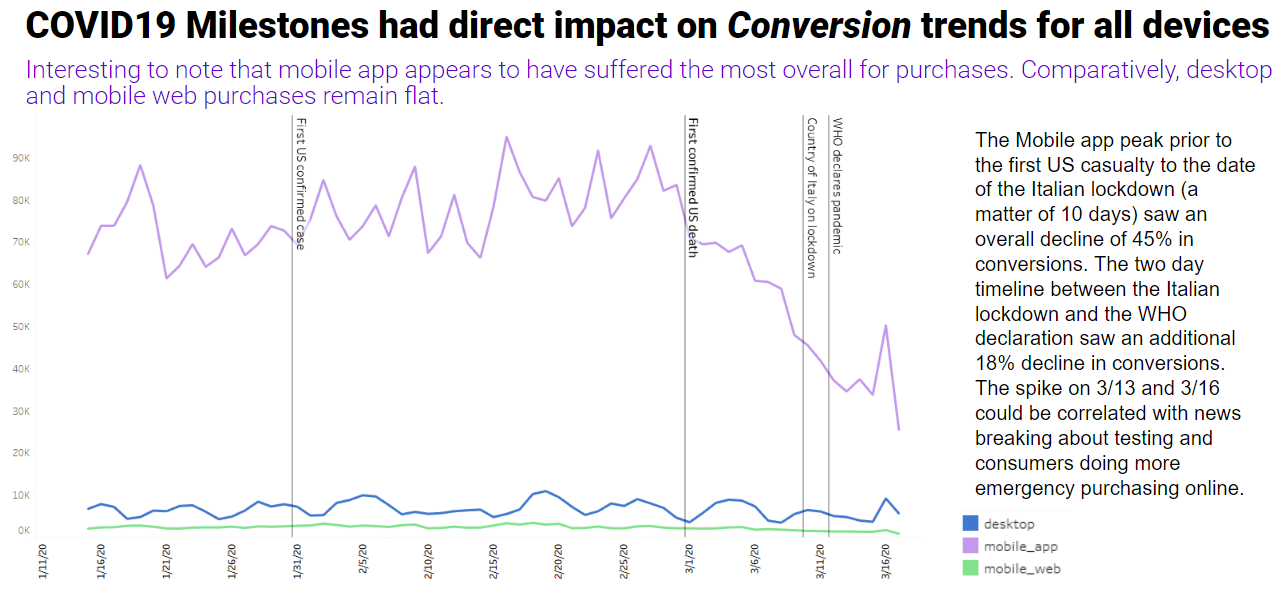
“All devices have seen significant changes in terms of clicks. For example, after the WHO pandemic declaration, we saw huge spikes in mobile clicks. The reason for that, from our side, is that news-related events were attracting a lot of attention as users looked to social media for what was happening across the world,” explains Richardson.
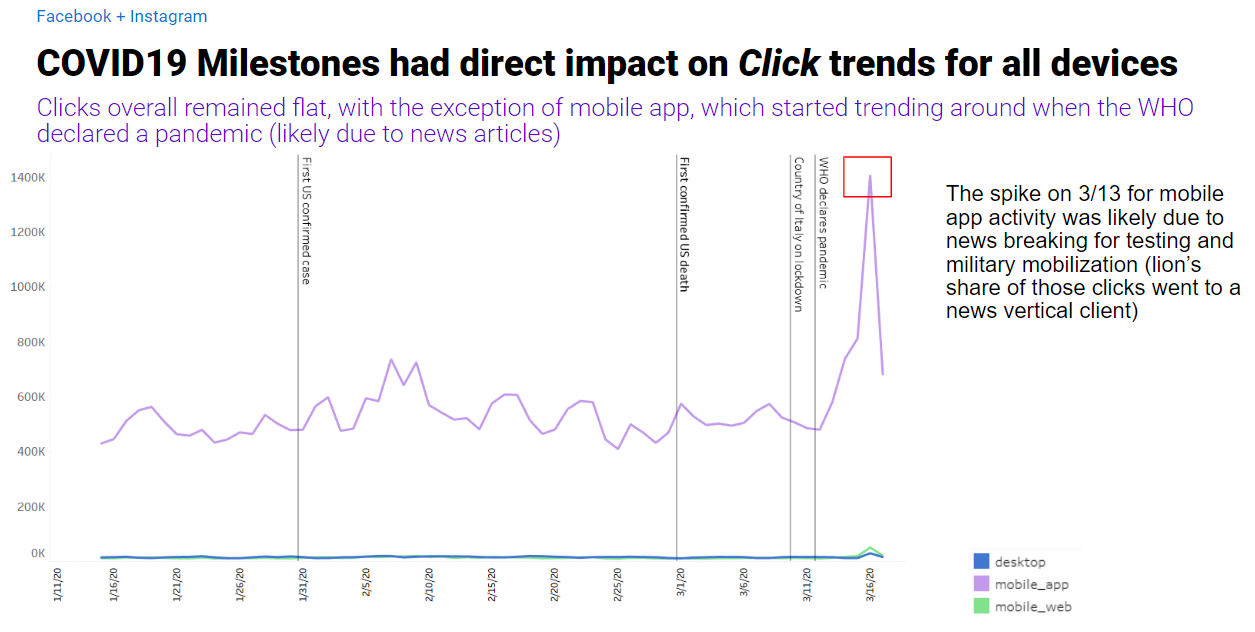
“The key takeaway is to look out for major milestones and start tracking against your consumers’ behaviors,” says Richardson.
“The better you can understand how each event impacts your audience’s behavior, the better you’ll be able to prepare for future shifts in performance.”
Conversions, conversion rates, and clicks for Bing and Google Search also appear to correlate with major COVID-19 milestones and announcements.
“We do see that conversion rates on the Bing and Google side dropping from 14% to 8% as of 3/16. We anticipate this to continue to happen at an aggregate level but for some specific types of businesses, it may not. It’s a similar story on the clicks and conversion side,” says Richardson.
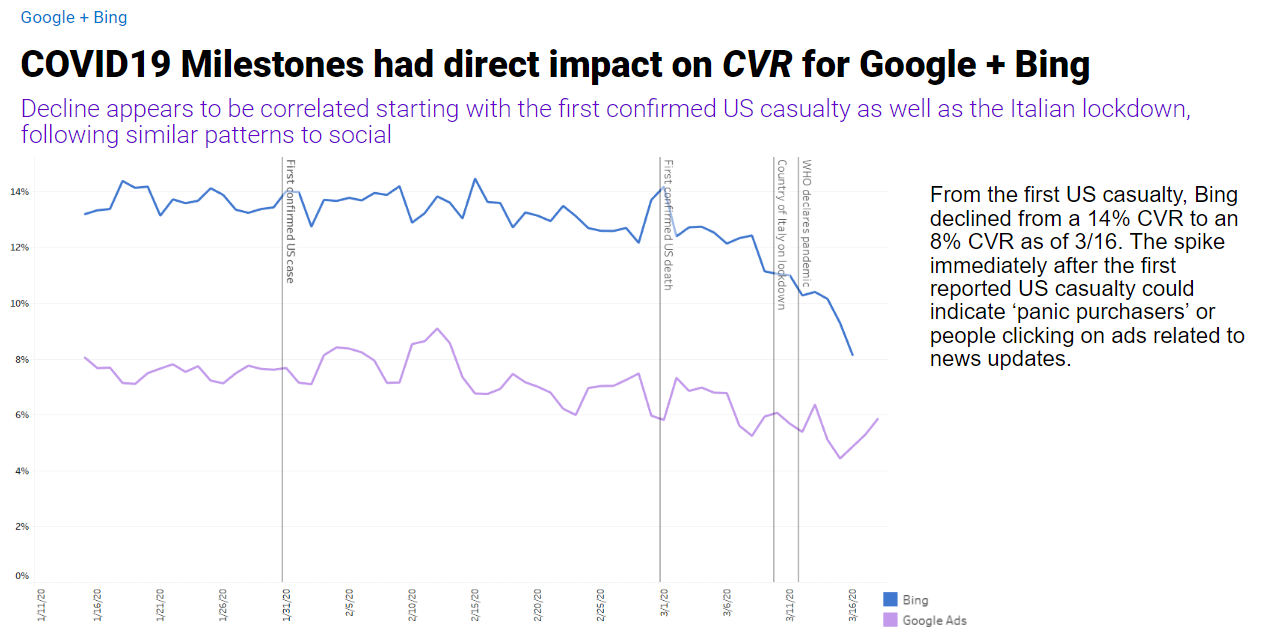

“Beyond the trends outlined above, we see significant increases in CPG and electronics in terms of both spend and conversion rates.”
“We are also seeing increases in many products that consumers are now shifting their purchases to online where they would have otherwise purchased in a brick and mortar store originally. Groceries, coffee, food delivery. Obviously we’ve seen significant changes with travel and tourism.”
“We are also seeing some interesting trends on the retail side. Shoes, sneakers, and sandals have experienced big increases in consumer interest. Items that are used for going outside are part of this trend.”
“In terms of messaging, the most successful we’ve seen are messages of empathy and compassion. Not just ‘come buy this now,’ but more along the lines of ‘we’re all in this together.'”
When it comes to budget adjustments, there’s no one-size-fits-all answer.

“Right now, you have to re-think your approach, and we’re here to help with that. Your messaging, audiences, measurement, creative, placements, etc. all need to be approached with extra attention given the circumstances.”
“In terms of budget adjustments, yes it makes sense to pause certain campaigns, channels, or messaging. It can also make sense to put additional spend behind others.”
“If you turn off all of your media, your competitors will jump on that and own your presence and we’ve seen that happen. This can also happen to your competitors, giving you the distinct advantage of showing up for that demand when they have stepped back.”
“There are several things to think about before making spend decisions. Number one, consider your vertical. A travel or tourism brand will have different priorities than a CPG or electronics brand. The second is consumer demand, can you meet the demand if you see an increase in consumer attention?”
While many marketers might instinctively shy away from the spotlight during COVID-19, the current circumstances provide an opportunity to showcase the best side of your brand.

“We don’t necessarily think less is more. We’ve seen some brands shift product and ad strategy to meet consumer expectations during a time of crisis. For example, we’ve seen some brands shift manufacturing to masks and hand sanitizer. We’ve seen brands like Guinness and Disney shift messaging to comfort consumers. These brands are still providing services and doing it in a unique way.”
“One client of ours just experiences their second-best day in terms of ecommerce because they made the decision to not de-invest. We changed the media mix and leveraged first-party data to target more effectively. For other clients that don’t have as strong first-party data, we’ve seen success in contextual and competitor targeting especially against competitors that have shuttered our shied away from pushing media.
“However there are times when it makes sense to draw back media spend, especially if it means freeing up liquidity to protect your employees from being laid off.”
“One of the most common questions we’ve received is how the Coronavirus is impacting ad trends across Amazon. In the US, we’ve seen more volatility than we typically see on a day-to-day or week-to-week basis, which speaks to the uncertainty that Richardson touched on that we see around consumer spending.”

— Jeff Coleman, VP of Marketplaces at Tinuiti
“With Amazon, all of our clients are in the retail space. What’s happening with your supply chain is likely impacting what’s happening with your advertising operations. That’s a big concern for many of our clients because you don’t want to waste spend on advertising a product if you don’t have that product ready to be shipped and sold in the first place.”
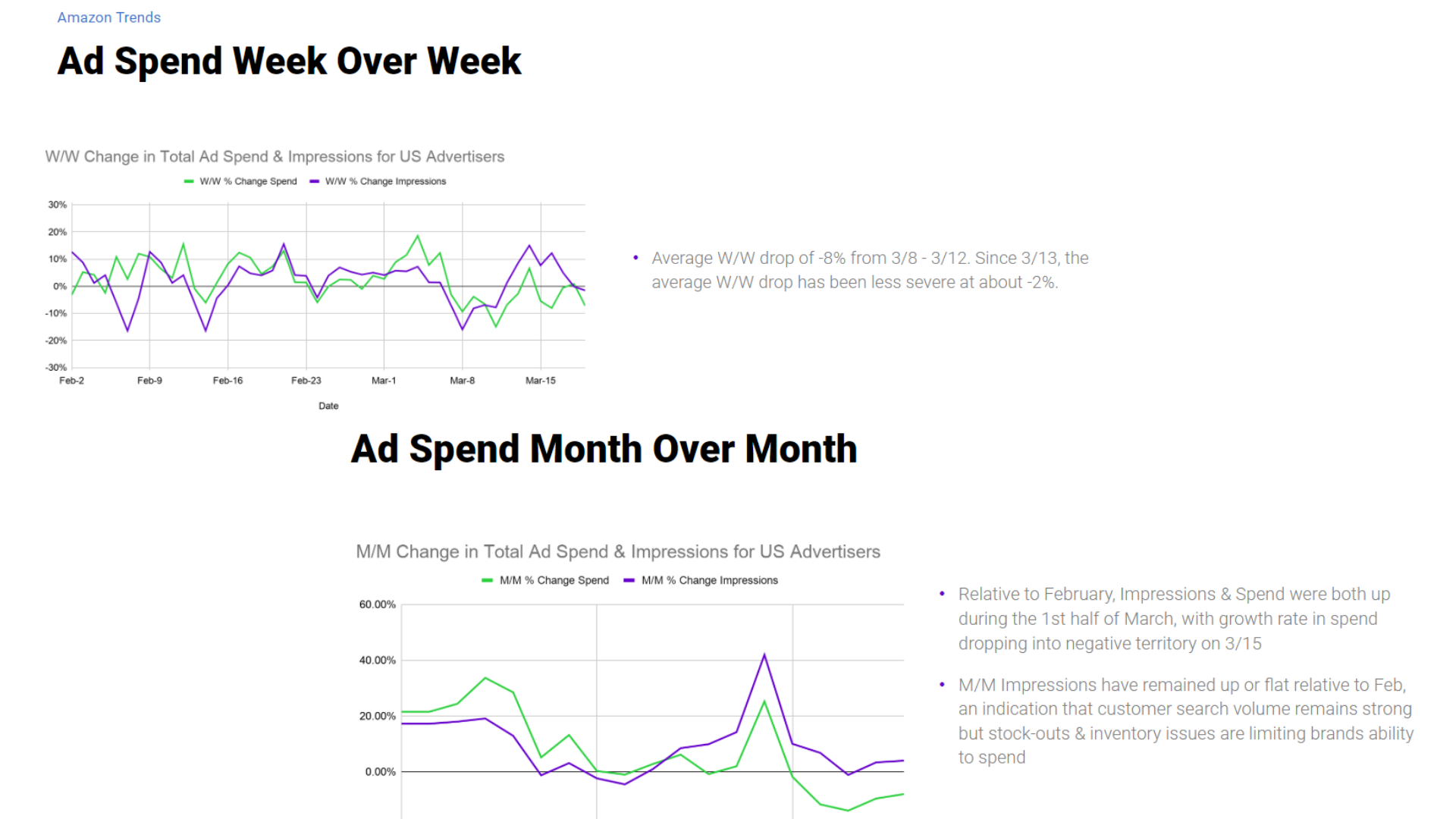
“One of the major trends we see is increases in customer search volume and impression count. We are also seeing a decrease in client spend month over month as a result of budget contraction due to brands protecting cash flow and stockouts due to lack of inventory in some categories.”
“The purple line shows that impression continues to rise, pointing to an increase in customer demand for products online. Consumers are turning to Amazon to replicate that shopping experience that they can’t get in-store.”
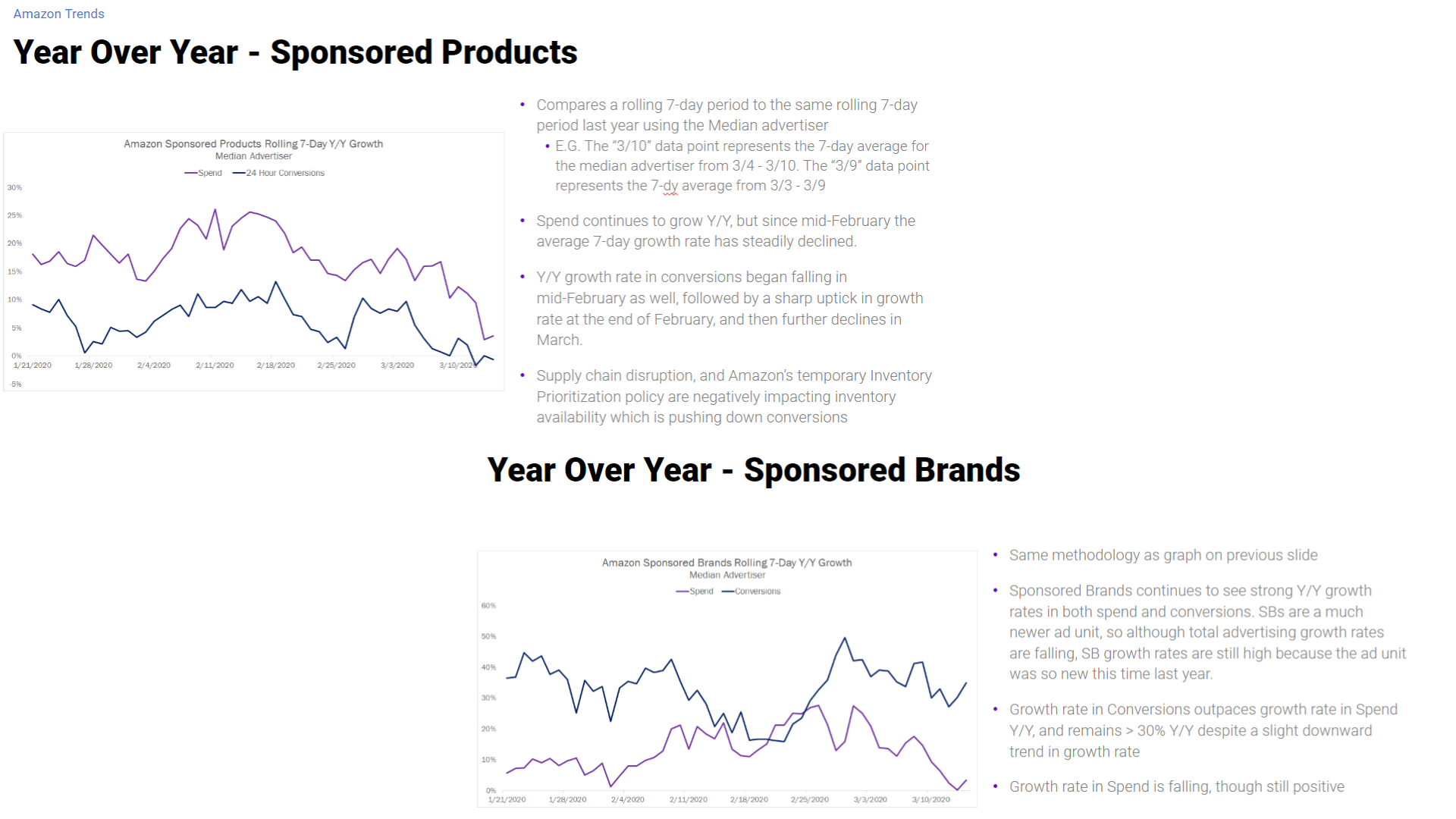
“In the above graph, you will see a look at two specific ad units which show different trends. Within both ad units, and Sponsored Products specifically, we see spend remaining strong year over year although it has seen some recent decline. Part of the reason for that is up until very recently, conversions were still up. As we get into March, we see the trendline start to flatten and a depression in conversions as a result of inventory and stock issues.”
“In Sponsored Brands, we see strong lifts in year over year spend and conversions, but take that with a grain of salt because it is a newer ad unit and we expected to see growth anyways, despite the current circumstances.”
One of the most asked questions around Amazon was in regard to its decision to suspend FBA fulfillment for “non-essential” items a couple of weeks ago, which was a cause for concern for many sellers that relied solely on Amazon FBA for logistics.

“The good news is Amazon just recently announced that they would be opening up inventory and shipments of non-essential items. However, the language is vague and conditions for what type of products are eligible for this are not known. We have seen some clients start to receive Purchase Orders for non-essential items, which is encouraging to see for brands that are selling items in non-essential categories.”

“One of the things we’ve been talking to our clients about is that you shouldn’t forget about the fundamentals of advertising during this time. This includes ROAS, conversion rate, how customers are interacting with your ads, your CTR. Your performance will fluctuate across different categories and that should impact your bidding and budgeting.”
“With that said, we advise you to not take a blanket approach across all of your campaigns on Amazon. This calls for diving into your catalog to understand how things are performing on a category and product-specific level. If you have inventory that’s ready to ship or will be ready when Amazon opens up POs for, you want to be able to capitalize on that as well as the opportunity to be present when other brands are backing away.”
“Evaluate your catalog on an individual ASIN basis and see where your opportunities are as well as where your opportunities are to cut back to preserve cash flow. Don’t take a one-size-fits-all approach.”

“Hopefully Amazon will lift these restrictions in the coming weeks, especially as they’ve already begun to assess which non-essential products can resume FBA fulfillment. However, if you need to act now then I recommend evaluating your current inventory coverage.”
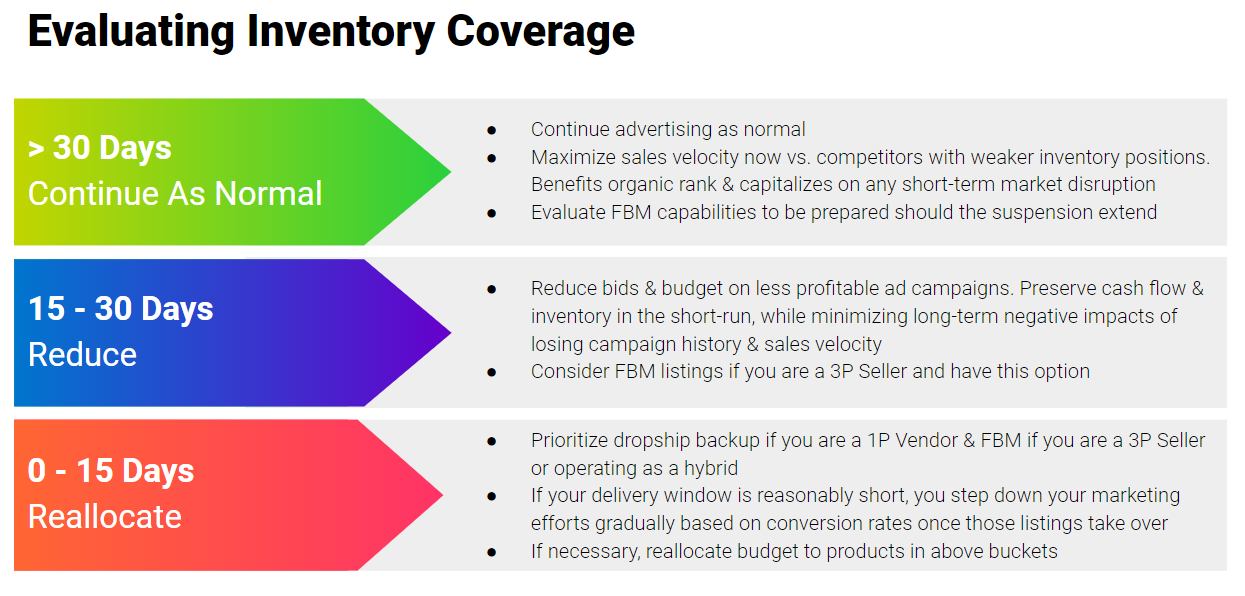
“We are helping our clients break down inventory into three buckets. You want to look at your catalog and products on an individual basis. If your inventory position is strong, then now is likely not the time to pull back on those products. Granted, you should always evaluate what’s happening with your conversion rates and ROAS before making any decisions. Those will be indicators whether customers are still interested in buying your products at the same rate.”
“If you’ve got the inventory to fill and customers are still buying them, then that’s an area you want to capitalize on. Products where you have less inventory coverage, those are products where you might consider pulling back. We still have only a week left of Amazon’s original timeline for shipment restrictions, which might be a short enough time for sellers to get by without having to pull back their spend.”
One of the most controversial questions is how brands should approach messaging, or if they should be saying anything at all during the Coronavirus pandemic.
“Do people want to listen to brands right now? Do they want advertising to come through? The answer is a resounding yes. Research from Kantar shows that 78% of consumers believe brands should help them in their daily lives and 75% of them want to be informed on what the brand is doing during the pandemic.”

— Tom Olivieri, VP of Creative at Tinuiti
“People are losing their sense of normalcy. In a time of isolation, they want communication, not radio silence,” explains Olivieri.
“People want to still feel like they have control over their lives. They still want to interact with their favorite products and brands, they want to hear from you.”
“However, this doesn’t mean to blast your message in a business-as-usual way. 74% of consumers also don’t want to see companies exploit the situation.”
“Being exploitative means not being mindful. We’re all in this and we need to recognize this. Understanding your audience and consumers isn’t exploitative as long as your approach it in a mindful way.”
Your messaging strategy during COVID-19 is essential both in the short-term as well as for preparing for the inevitable rebound once the crisis is over, which calls for careful attention to sensitivity and empathy for your customers.

“Number one is you need to be mindful, which means recognizing that we are in this situation. You can’t run the same ads that you planned three months ago. For example, you wouldn’t run your March Madness campaigns or TV spots right now.”
“You also have to be meaningful. This is your chance to show the emotional side of your brand, not the hard sell. Show that you understand who your audience is, what they’re facing, and where you fit in that new world as a brand.”
“Your brand can still fit into their daily lives. For example, if you are a restaurant, you can still deliver or show online cooking classes. But above all, don’t forget who you are as a brand. Don’t sacrifice authenticity for short-term gain, don’t change your voice overnight. Be true to yourself.”
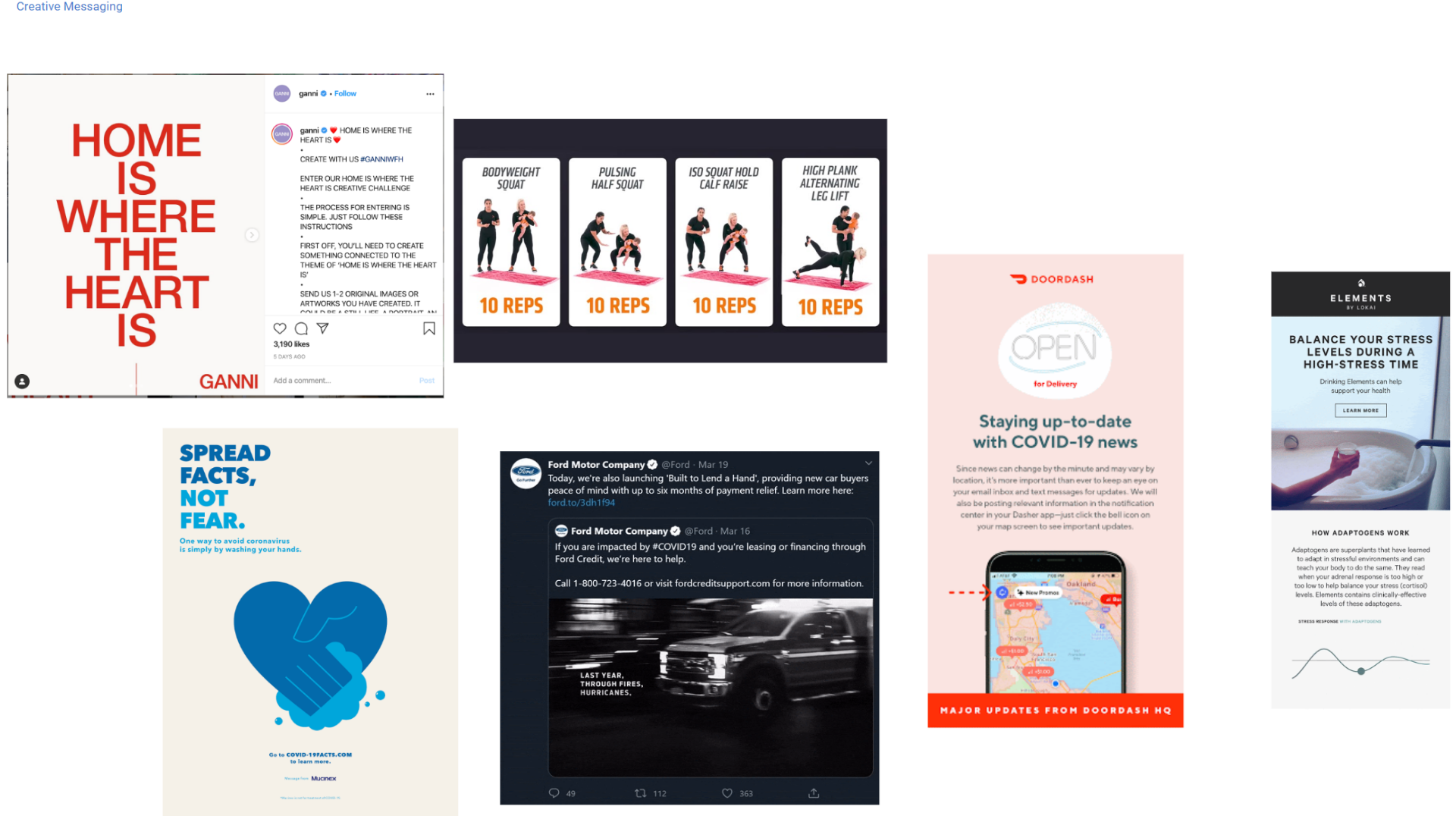
“For example, take Orange Theory Fitness. Of course, their locations are closed, but that doesn’t mean they’ve gone dark. They’re still delivering their message and show that they still care about their customers by providing those workouts online so that their audience can still stay in shape while remaining at home.”
“People are clamoring for control during chaos. If you can help your customers take control of their life; through home workouts, stress relief, a useful product or helpful information, then your brand is helping your customers win. They will remember that long after this crisis is over.”
While the current crisis may trigger a flight response for many marketers, it’s now more important than ever to be yourself and think about how your brand can make a positive impact on consumers.
If you want to learn more channel-specific strategies to help your marketing during this time, check out our live recording, the COVID-19 Resource Hub, and sign up for our free COVID tracker to stay up to date on the latest trends.
Have any more questions or advice around how businesses should approach marketing to consumers during Coronavirus?
Drop us a comment below!
